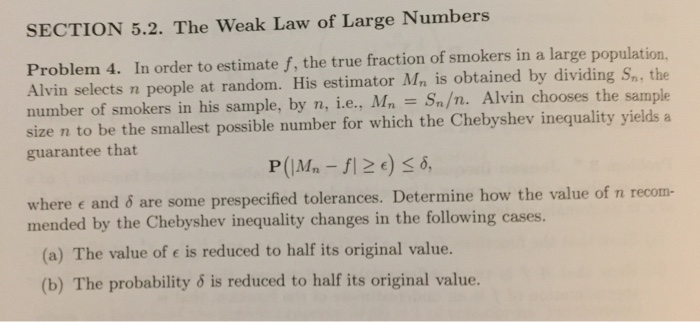Answer appropriately
What is the difference between univariate data and bivariate data? Choose the correct answer below. 0 A. In univariate data, a single variable is measured on each individual. In bivariate data, two variables are measured on each individual. 0 B. In univariate data, there are only positive values and zeros. In bivariate data, there are positive values, negative values, and zeros. O C. In univariate data, there is one mean. In bivariate data, there are two means. 0 D. In univariate data, the data are qualitative. In bivariate data, the data are quantitative. 2. Recall that Markov's inequality says that if T' is a positive-valued random variable with mean E(T) then E(T) P(T > 1 ) 0 there holds P(1X - #| Ska) 21 - 1 That is. with probability at least 1 - 2. X stays within & standard deviations around its mean.SECTION 5.2. The Weak Law of Large Numbers Problem 4. In order to estimate f, the true fraction of smokers in a large population. Alvin selects n people at random. His estimator Mn is obtained by dividing Sn, the number of smokers in his sample, by n, i.e., Mn = Sn. Alvin chooses the sample size n to be the smallest possible number for which the Chebyshev inequality yields a guarantee that P(IMn - 1 Z E) 56, where e and o are some prespecified tolerances. Determine how the value of n recom- mended by the Chebyshev inequality changes in the following cases. (a) The value of e is reduced to half its original value. (b) The probability o is reduced to half its original value.2. (10 points)(The Weak Law of Large Numbers) In order to estimate 3", the true fraction of smokers in a large population, Alvin selects u. people at random. His estimator Mn is obtained by dividing S", the number of smokers in his sample, by N, i.e., Mn = \"/11. Alvin chooses the sample size n to be the smallest possible number for which the Chebyshev inequality yields a guarantee that PiIMnfl 2 6) 5: where E and 6 are some prespeeied tolerances. Determine how the value of 11 recommended by the Chebyshev inequality changes in the following cases. (a) (5 points] The value of e is reduced to half its original value. (b) (5 points] The value of 5 is reduced to half its original value










